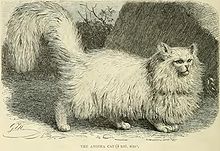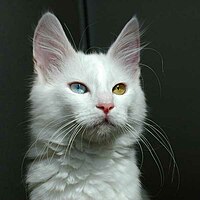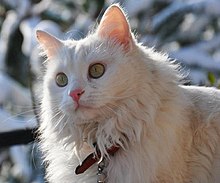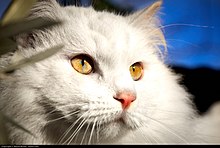Owning and interacting with pets, according to studies, can be a form of therapy for many. We have dedicated Saturday to dogs and Wednesday to cats, when we will post an article on each of those days. We will also post articles on occasion about other animals people may have as pets. – Editorial Team
Turkish Angora Cat
The Turkish Angora (Turkish: Ankara kedisi, ‘Ankara cat’[3]) is a breed of domestic cat. Turkish Angoras are one of the ancient, natural breeds of cat, having originated in central Anatolia, (modern-day Turkey, Ankara region). The breed has been documented as early as the 17th century. The breed is also sometimes referred to as simply the Angora or Ankara cat.[3]
History

“Angora cat” from The Royal Natural History (1894), illustrated by Gustav Mützel

A white Turkish Angora cat with odd eyes (heterochromia), which is common among the breed
Like all domestic cats, Turkish Angoras descended from the African wildcat (Felis lybica). Their ancestors were among the cats that were first domesticated in the Fertile Crescent.
Longhaired cats were imported to Britain and France from Asia Minor, Persia and Russia as early as the late 16th century. The Turkish Angora was recognized as a distinct breed in Europe by the 17th century.[4] However, there is a strong connection between Angoras and Persians. Charles Catton, in the 1788 book Animals Drawn from Nature and Engraved in Aqua-tinta, gave “Persian cat” and “Angora cat” as alternative names for the same breed.[5]
The Persian cat was developed from Turkish Angora mutations by British and American cat breeders. In 1903, F. Simpson wrote in The Book of the Cat:[6]
“In classing all long-haired cats as Persians I may be wrong, but the distinctions, apparently with hardly any difference, between Angoras and Persians are of so fine a nature that I must be pardoned if I ignore the class of cat commonly called Angora, which seems gradually to have disappeared from our midst. Certainly, at our large shows there is no special classification given for Angoras, and in response to many inquiries from animal fanciers I have never been able to obtain any definite information as to the difference between a Persian and an Angora cat.”
The Angora of the 20th century was used for improvement in the Persian coat, but the type has always been divergent from the Persian – particularly as the increasingly flat-faced show cat Persian has been developed in the last few decades.
In the early 20th century, Atatürk Forest Farm and Zoo began a breeding program to protect and preserve pure white Angora cats.[7] The zoo particularly prized odd-eyed specimens; however, the cats were chosen only for their color—no other criterion was applied.
The Turkish Angora, which was brought to Canada in 1963, was accepted as a championship pedigreed breed in 1973 by the Cat Fanciers’ Association.[8] However, until 1978 only white Angoras were recognized. Today, all North American registries accept the Turkish Angora in many colors and patterns. While their numbers are still relatively small, the gene pool is continually growing.
Breeders in Turkey feel that the cat’s fine-boned version of its natural breed is unrepresentative of the true Turkish cats, which are much sturdier. American “Turkish” Angoras have only a minimal remnant of the original Atatürk Forest Farm and Zoo DNA, and are only “purebred on paper”.[9]
Appearance
Turkish Angora cats have long, silky coats, and elegant, sinuous bodies. A young Turkish Angora may be mistaken for a snow weasel. Though it is known for a shimmery white coat and posh tail, Turkish Angora cats can display a variety of colors.[10]They come in tabby, black, chocolate brown, and smoke-colored varieties.[11][12]
Eyes may be blue, green, amber, yellow, as well as heterochromatic. Ears are pointed, large and wide-set. The eyes are almond shaped and the profile forms two straight planes. The plumed tail is often carried upright, perpendicular to the back.[11]
Behavior
Turkish Angora cats are playful, intelligent, athletic and involved. They bond with humans, but often select a particular member of a family to be their constant companion, whom they are very protective of.[10] They seek to be “helpful” in any way they can with their humans, and their intelligence can be at times remarkable, showing basic problem solving skills. They are easily trained because of their intelligence and desire to interact with humans.
Turkish Angoras are energetic, and often seek out “high ground” in the home. This perch is then used as a way to observe activity of the home.[10]This can include tops of doors, refrigerators, bookshelves, and other furniture. Some ride on their owners’ shoulders. Most get along well in homes with other animals or children, or homes with high activity.
Health
The gene responsible for the deaf white cat occurrence is present in most Turkish Angora cats.
Some Turkish Angora kittens suffer from hereditary ataxia, a rare condition thought to be inherited as an autosomal recessive.[13] The kittens affected by ataxia have shaky movements, and do not survive to adulthood.
Another genetic illness that is rare but known to the breed is hypertrophic cardiomyopathy,[14] which is a cardiac condition usually found in cats between the ages of 2 to 6 years old, with males being affected more commonly and more severely than females. In the Turkish Angora, the disease has not yet been studied at length, primarily due to its rarity of occurrence.
Genetics
A genetic study of pedigree cat breeds (using DNA taken from pedigreed cats in the U.S. and Europe) and worldwide random-bred populations showed the Turkish Van as a distinct population from the Turkish Angora despite their geographical association. The Turkish Angora was grouped with the pedigreed Egyptian Mau and random-bred Tunisian cats. Turkish random-bred cats were grouped with Israeli random-bred cats while the Turkish Van was grouped with Egyptian random-bred cats.[15] However, the UC Davis only studied American cat fancy registered Angoras rather than the “true” Turkish Angora or Ankara Kedisi directly from Turkey, and especially from the Ankara Zoo.[9]
A genetic study published in 2012[16] included a few cats imported from Turkey. The study found that ″Turkish- versus USA-originating Turkish Angoras (…) are resolved as separate breed populations[16] The American Turkish Angoras are categorized as descendants of European random-bred cats, and cats imported from Turkey ″were assigned to the Eastern Mediterranean″ group.[16]
Source: Wikipedia under Creative Commons License.









